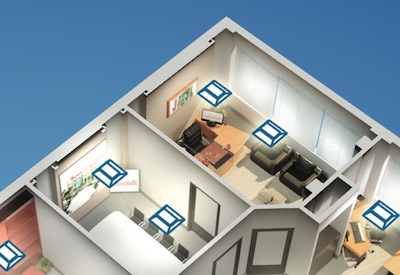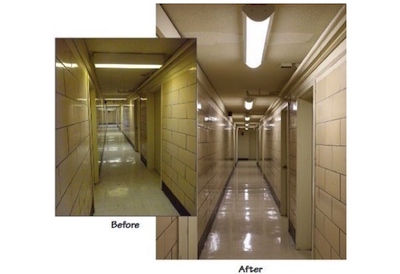Talking to IT Departments About Connected Lighting

November 6, 2018
Networked lighting control systems (NLCs) are really computer networks — they just happen to control luminaires, occupancy sensors, photosensors and light switches. The paradigm shift for lighting control systems has occurred at lightning-fast speed in recent years.
It is absolutely possible for you to specify, install and operate a networked lighting control system that is completely standalone, meaning that nothing whatsoever interacts with the NLC system in your (or your client’s) building. However, many systems are now being installed using an existing IT network to connect components of the NLC. A common example is when a central server must connect via wires (typically Ethernet cable) to wireless gateways. The central server is often located in an electrical closet or IT room in the core of the building. The gateways are usually located in the occupied space. To connect these components, cable must be run from the core out to the finished space. If an existing network is available, it’s usually possible to connect the server to the gateways using that network. The commissioning agent simply needs to know the IP addresses of the gateways and tell the server to look for them on the network.
Sounds simple, right? And in the process, you can save money because you don’t have to puncture core walls and run additional Ethernet cable. However, once you decide to piggyback onto an existing IT network, you are in the domain of the IT staff who work for the building’s owner. The IT staff have two main responsibilities:
1. Make sure that the IT networks are up-and-running and work 24/7.
2. Protect the owner from hacking/intrusions/problems.
Unless you’ve been living on Saturn for the past five years, you know that hacking into existing networks has become a huge concern in our society. Arguably, the second responsibility — protecting the owner from hacking — is a much more critical task for any IT professional than initially getting the networks up and running. This gives the IT staff enormous power and allows them to wield enormous influence.
What are some best practices for dealing with the IT staff when you use an NLC that will be integrated with existing network infrastructure? Here’s a partial list:
1. Talk with the IT staff early and often. Not only is this important from a “political” viewpoint (to get buy-in), but the IT staff may also have specific requirements, restrictions or prohibitions that will impact your choice of a recommended NLC. For example, a particular building owner might consider installing an NLC, but only if it’s wired and not wireless. They may have concerns about interference with existing wireless networks if another wireless system is installed in the same spaces. Needless to say, that’s a major issue, and you’d want to know about this as early in the process as possible.
2. Don’t fight with IT professionals! Because of the sensitivity of their job — in protecting the owner’s existing networks and information — these folks wield substantial power, at least when it comes to the IT infrastructure. One word from an IT staff person can shut down the possibility of installing an NLC in an existing building (or even a new building for that matter). Even if you don’t like the IT person’s personality or how he or she interacts with you, make it a point to think of them as part of the team that will help you specify and deploy an NLC that the owner will like and will benefit from. Just like anyone else, IT staff people may come across as prickly — maybe more so considering how critical their job function is. Do not let that sour your interaction with these folks. That is an enormous mistake.
3. Realize that the IT staff probably don’t know much about lighting and lighting controls. Considering the advances in IoT, increasing numbers of IT professionals may understand more about lighting going forward. Keep in mind, however, that lighting and lighting controls have only recently entered the “digital age” — where luminaires, sensors and switches are now connected devices on a computer network. An IT staff person with whom you are working may or may not know much about luminaires or lighting control devices, and they may or may not care about that either. What they do care about, however, is the IT aspect of what you may be recommending. If you are working with an IT staff person who is interested in learning more about the lighting aspect of the NLC deployment, by all means educate him or her about that. If not, be content to stick with the IT issues when talking with that person.
4. Listen to and carefully consider their advice about NLC system architecture and equipment. Many NLC systems allow you to install and connect components in a variety of ways. If an IT professional asks about or suggests connecting things in very specific ways, there may be a very good reason for that. If what they are asking for absolutely cannot be done using the NLC system you are considering, you are welcome to explain that. However, make sure it is a respectful conversation involving give and take. There may be extremely important reasons why they are asking about, strongly suggesting, or even requiring a specific architecture for the system.
5. Security, security and security! Just as “location, location and location” are the three most important things in real estate, security is far and away the most sensitive and critical aspect of the IT staff’s job. Do not assume that whatever methods of security are available in the system(s) you may propose are acceptable to the IT staff. They may have much higher standards about things like encryption, modes of access, and lots more. For example, it’s fairly standard these days for manufacturers to build in 128-bit AES encryption into their system’s software. What if the IT staff require 256-bit AES encryption? Here’s another example. You may want to propose an NLC system that allows for remote access, perhaps by building engineers to check and fix problems in the system even if they are not on site at the time. Many systems allow remote access as long as the NLC is connected to the Internet. This is a potential security problem. The IT staff may be okay with this, but only if the user is required to access the server remotely using a VPN, or only if there is a robust login/password methodology. If not, then this may not work. It’s really essential to make these kinds of determinations as early in the process as possible.
6. Make sure that you communicate with the IT staff throughout the deployment process. Don’t assume that because you had an initial conversation at the outset of the project, the IT staff now have buy-in to every aspect of the NLC selection and deployment. Do make sure that you inform them every step of the way. It’s likely that you will need assistance from the IT staff at various points throughout the process. For example, during commissioning, you may need them to assist you by assigning static IP addresses for specific equipment that you connect to their network. That’s not the kind of thing that a commissioning agent would typically do on their own, nor should they.
7. Make a point of learning more about IT over time. Computer and IT technology are not things that most lighting designers, electrical engineers, distributors and lighting salespeople study in school. This is new stuff to a lot of people in the lighting industry. Do not let that stop you from learning more about IT issues. Be a lifelong learner! So the paradigm has shifted — so what? Things change. The more you can learn about IT and how networks operate, the easier your job will be of interfacing with IT staff and successfully deploying an NLC on your next project.
This article was first published at lightingcontrolsassociation.org/2018/09/10/steve-mesh-on-talking-to-it-departments-about-connected-lighting/.
Steven Mesh is an award-winning lighting designer who has designed lighting and control systems for a variety of project types (commercial, museums, schools, residential, restaurants, retail, historic, healthcare, etc.). As an educator, he has taught classes and given presentations about lighting and controls across North America and internationally. One of his is developing lighting and lighting controls courses that rely on hands-on and/or interactive content. He has been a repeat speaker at LightFair for eight years.












